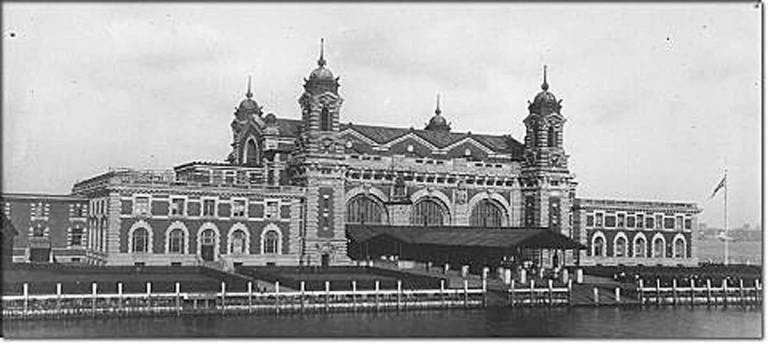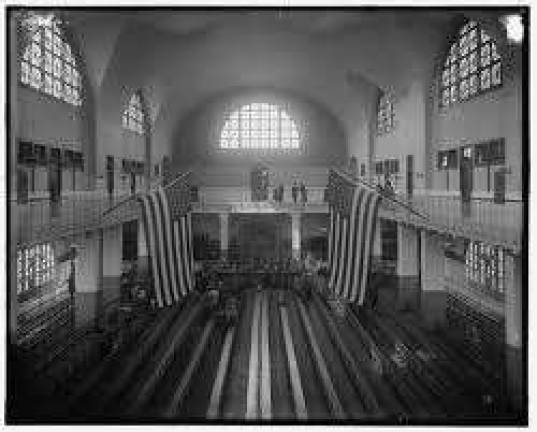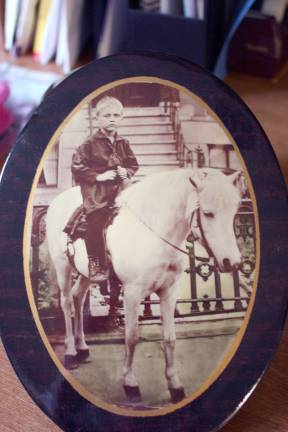For millions, Ellis Island was the gateway to America



The island history Ellis Island is widely known as the historic location of the immigrant screening station that serviced countless travelers looking to begin a new life in America, arriving sometimes with only a pocketful of hopes and dreams. But the island itself had a rich history before it became the entry-way to the New World.
In the early 1600s the Mohegan Indians called the 2-3 acre tract of land Gull Island. At high tide it all but disappeared. In 1628 Dutch settlers discovered rich oyster beds around the island in Upper New York Bay and named it Oyster Island.
The hanging of Anderson the Pirate in 1765 brought about another name change. Anderson, its told, was captured on the island, put to death then hung on a gibbet, a structure that held the bodies of the executed for public display. For the next 20 years it was called Gibbet Island until Samuel Ellis purchased the land.
The State of New York bought it next and in 1808 it was sold to the federal government for $10,000. It served as an Army facility, Fort Gibson, until 1876 when the Navy took it over utilizing it as a munitions depot. New Jersey residents, however, complained about the huge amounts of volatile powder stored there and the depot closed in 1890.
Meanwhile Castle Garden, a small Manhattan immigrant screening station, was becoming obsolete. Ellis Island was chosen as the new station site and over the next two years, by means of landfill, it grew to 14 acres, large enough to house the station and its support buildings.
In 1892 a two-story pine building with stately towers opened for operation. The Registry Room, with its 56-foot vaulted ceiling, contained 12 aisles which channeled new arrivals to examination areas. While regal in appearance, the structure had significant problems. Resting on wood piles, the foundation was insecure, the materials were of poor quality and the roof was a source of concern. Even the doors were falling off. In 1897, a kitchen fire spread, destroying most of the station.
Ellis Island shut down for several years. The island was expanded to 17 acres with the eventual addition of two new adjacent islands, constructed with debris from the Grand Central Station excavation site. In 1900, the new station opened. Designed like a train station, it allowed travelers to pass through quickly. Between 1900 and 1914, Ellis Islands peak years, between 5,000 and 10,000 immigrants passed through the station each day. By 1910, 13.5 million immigrants were living in the United States.
While about 20 percent of the newcomers faced disqualification or detention, the other 80 percent scattered to New York and New Jersey, seeking transportation to their final destinations around the country.
The Congressional Emergency Quota Act of 1921 and the following Immigration Act of 1924 restricted the influx of immigrants. In 1930, during the Great Depression, more people emigrated from the United States than immigrated to it.
By 1954, due to stricter laws and a decrease in migration, the station moved back to Manhattan and Ellis Island closed. The last person to pass through the station in 1954 was Arne Peterssen, a Norwegian merchant seaman.
The People The first person to pass through the Ellis Island station was Annie Moore, a 15-year old from Ireland. Upon arrival on Jan. 1, 1892, she was warmly greeted and gifted with a $10 gold piece.
Ahead of Moore, and all subsequent immigrants, lay the workforce in the Great Hall; inspectors, interpreters, nurses, doctors and social workers. Their primary duty was to ensure that all those entering the United States were medically and legally fit to do so.
Each immigrant was checked for 60 diseases or disabilities that could bar their entry. Those under suspicion were marked with an X for further examination, a B meant a return to their homeland.
One particularly painful examination, long-remembered by immigrants, was for trachoma, a contagious eye disease. In order to determine the presence of disease, the doctors used a button hook to turn the immigrants eyelids inside out. Trachoma caused more detainments than any other disease.
Immigrants with curable illnesses were moved to the islands hospital. Whether an immigrant passed or failed their inspections, they were all directed to one of the three sections of the Staircase of Separation. Right, left or center.
At the bottom of the stairs lay their immediate destinies. A right turn led to a railroad ticket office; a left turn lead to a ferry to Manhattan; straight ahead led to the detention rooms.
One four-year-old boy, Haakon Magnussen, arrived from Arendal, Norway, with his grandparents on Aug. 16, 1920. Like many divided immigrant families, his mother remained in Norway for financial reasons.
After a long sea journey on board The Bergensfjord out of Kristiania, the little boy was found to be healthy, but there was concern as to the grandparentss ability to support the child. So the grandparents were lead to the left staircase, the little boy to the center – and to detention.
One can only imagine the grandparentss emotions. Traveling across the ocean with the little tow-head in their charge, only to have to leave him alone in a new country while they went about proving they could care for him.
Haakon had to remain on Ellis Island for a month. He didnt remember much about it except that he had to eat too many peanut butter sandwiches.
His grandparents supported him and raised him well. By the age of 10 he was going to school and working part time on a family fishing boat out of Brooklyn, N.Y. He worked for the rest of his life on New York waters – and never ate a peanut butter sandwich again.
Heres to our ancestors who passed through Ellis Island. They enriched the fabric of our nation.
Sources: genealogyspot.com, sites.bergen.org, www.ellisisland.org, www.newsmax.com, www.en.wikipedia.corg, www.history.com, www.nps.gov, www.statueofliberty.com, Oracle Think Quest, Magnussen family memorabilia